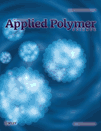The influence of forming conditions on the properties of the fibers made of chitin butyryl-acetic copolyester for medical applications
Abstract
This work describes the impact of basic parameters of the forming process on the macroscopic structure, sorption properties, and strength of fibers made of chitin butyryl-acetic copolyester (BOC). Regardless of the chemical structure of chitin BOC and intrinsic viscosity of polymer, solutions used in the spinning industry are non-Newtonian fluids diluted by shearing without flow boundary. Obtained fibers have a high total pore volume; thus, they may be classified into the group of highly porous fibers. The nature of the porous structure and the total pore volume result in high sorption properties of this hydrophobic material and in very high values of water retention. At the same time, fibers made of chitin derivatives have a good tenacity exceeding 24 cN/tex. © 2012 Wiley Periodicals, Inc. J. Appl. Polym. Sci., 2013




